Merlin
| Merlin | |
|---|---|
| Matter of Britain character | |
|
The Enchanter Merlin, Howard Pyle's illustration for The Story of King Arthur and His Knights (1903) | |
| First appearance | Prophetiae Merlini |
| Created by | Geoffrey of Monmouth |
| Information | |
| Occupation | Prophet, wizard |
| Significant other(s) | Lady of the Lake, Morgan le Fay |
Merlin (Welsh: Myrddin) is a legendary figure best known as the wizard featured in Arthurian legend and medieval Welsh poetry. The standard depiction of the character first appears in Geoffrey of Monmouth's Historia Regum Britanniae, written c. 1136, and is based on an amalgamation of previous historical and legendary figures. Geoffrey combined existing stories of Myrddin Wyllt (or Merlinus Caledonensis), a North Brythonic prophet and madman with no connection to King Arthur, with tales of the Romano-British war leader Ambrosius Aurelianus to form the composite figure he called Merlin Ambrosius (Welsh: Myrddin Emrys).
Geoffrey's rendering of the character was immediately popular, especially in Wales.[1] Later writers expanded the account to produce a fuller image of the wizard. Merlin's traditional biography casts him as a cambion: born of a mortal woman, sired by an incubus, the non-human from whom he inherits his supernatural powers and abilities.[2] Merlin matures to an ascendant sagehood and engineers the birth of Arthur through magic and intrigue.[3] Later authors have Merlin serve as the king's advisor and mentor to the knights until he is bewitched and imprisoned or killed by the Lady of the Lake.[3] He is popularly said to be buried in the magical forest of Brocéliande.
Name and etymology

The name "Merlin" is derived from the Welsh Myrddin, the name of the bard who was one of the chief sources for the later legendary figure. Geoffrey of Monmouth Latinised the name to Merlinus in his works. Medievalist Gaston Paris suggests that Geoffrey chose the form Merlinus rather than the regular Merdinus to avoid a resemblance to the Anglo-Norman word merde (from Latin merda) for feces.[4]
Clas Myrddin or Merlin's Enclosure is an early name for Great Britain stated in the Third Series of Welsh Triads.[5] Celticist A. O. H. Jarman suggests that the Welsh name Myrddin (Welsh pronunciation: [ˈmərðɪn]) was derived from the toponym Caerfyrddin, the Welsh name for the town known in English as Carmarthen.[6] This contrasts with the popular folk etymology that the town was named for the bard. The name Carmarthen is derived from the town's previous Roman name Moridunum,[4][6] in turn derived from Celtic Brittonic moridunon, "sea fortress".[7]
Geoffrey and his sources
Geoffrey's composite Merlin is based primarily on the legendary "madman" poet and seer Myrddin Wyllt ("Myrddin the Wild", sometimes called Merlinus Caledonensis in later sources influenced by Geoffrey), and Emrys (Old Welsh: Embreis), a fictional character based in part on the 5th century, historical war leader Ambrosius Aurelianus mentioned in one of Geoffrey's primary sources, the early 9th century Historia Brittonum.[8] The former had nothing to do with King Arthur: in British poetry he was a bard driven mad after witnessing the horrors of war, who fled civilization to become a wild man of the wood in the 6th century.[9] Geoffrey had Myrddin Wyllt in mind when he wrote his earliest surviving work, the Prophetiae Merlini (Prophecies of Merlin), which he claimed were the actual words of the legendary poet and madman.
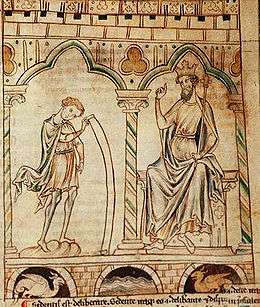
Geoffrey's Prophetiae do not reveal much about Merlin's background. He included the prophet in his next work, Historia Regum Britanniae, supplementing the characterisation by attributing to him stories about Aurelius Ambrosius, taken from Nennius' Historia Brittonum. According to Nennius, Ambrosius was discovered when the British king Vortigern was trying to erect a tower. The tower always collapsed before completion, and his wise men told him that the only solution was to sprinkle the foundation with the blood of a child born without a father. Ambrosius was rumoured to be such a child but, when brought before the king, he revealed the real reason for the tower's collapse: below the foundation was a lake containing two dragons who fought a battle representing the struggle between the invading Saxons and the native Celtic Britons. Geoffrey retells this story in his Historia Regum Britanniæ with some embellishments, and gives the fatherless child the name of the prophetic bard Merlin. He keeps this new figure separate from Aurelius Ambrosius and, with regard to his changing of the original Nennian character, he states that Ambrosius was also called 'Merlin'—that is, 'Ambrosius Merlinus'. He goes on to add new episodes that tie Merlin with King Arthur and his predecessors.
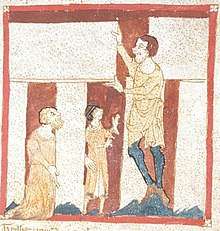
Geoffrey's account of Merlin Ambrosius' early life in the Historia Regum Britanniae is based on the tale of Ambrosius in the Historia Brittonum. He adds his own embellishments to the tale, which he sets in Carmarthen, Wales (Welsh: Caerfyrddin). While Nennius' Ambrosius eventually reveals himself to be the son of a Roman consul, Geoffrey's Merlin is begotten on a king's daughter by an incubus demon. (The name of Merlin's mother is not usually stated, but is given as Adhan in the oldest version of the Prose Brut.[10]) The story of Vortigern's tower is essentially the same; the underground dragons, one white and one red, represent the Saxons and the Britons, and their final battle is a portent of things to come. At this point Geoffrey inserts a long section of Merlin's prophecies, taken from his earlier Prophetiae Merlini. He tells only two further tales of the character. In the first, Merlin creates Stonehenge as a burial place for Aurelius Ambrosius, bringing the stones from the Preseli Hills in south-west Wales and Ireland. In the second, Merlin's magic enables the British king Uther Pendragon to enter into Tintagel in disguise and father his son Arthur with his enemy's wife, Igraine. These episodes appear in many later adaptations of Geoffrey's account. As Lewis Thorpe notes, Merlin disappears from the narrative after this; he does not tutor and advise Arthur as in later versions.[3]
Geoffrey dealt with Merlin again in his third work, Vita Merlini. He based it on stories of the original 6th-century Myrddin, set long after his time frame for the life of Merlin Ambrosius. Geoffrey tried to assert that the characters are the same with references to King Arthur and his death, as told in the Historia Regum Britanniae. Here, Merlin survives Arthur.
Nikolai Tolstoy[11] hypothesizes that Merlin is based on a historical personage, probably a 6th-century druid living in southern Scotland. His argument is based on the fact that early references to Merlin describe him as possessing characteristics which modern scholarship (but not that of the time the sources were written) would recognize as druidical—the inference being that those characteristics were not invented by the early chroniclers, but belonged to a real person. If so, the hypothetical Merlin would have lived about a century after the hypothetical historical Arthur. A late version of the Annales Cambriae (dubbed the "B-text", written at the end of the 13th century) and influenced by Geoffrey,[12] records for the year 573, that after "the battle of Arfderydd, between the sons of Eliffer and Gwenddolau son of Ceidio; in which battle Gwenddolau fell; Merlin went mad." The earliest version of the Annales Cambriae entry (in the "A-text", written c. 1100), as well as a later copy (the "C-text", written towards the end of the 13th century) do not mention Merlin.[13]
Later versions of the legend
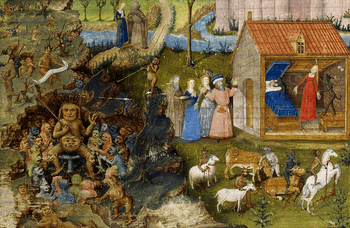
Several decades later, Robert de Boron retold and expanded on this material in his poem Merlin written around 1200. Only a few lines of the poem have survived, but a prose retelling became popular and was later incorporated into chivalric romances. In Robert's account, as in Geoffrey's Historia, Merlin is begotten by a demon on a virgin as the intended Antichrist. This plot is thwarted when the expectant mother informs her confessor Blase (or Blaise) of her predicament; they immediately baptize the boy at birth, thus freeing him from the power of Satan and his intended destiny. The demonic legacy invests Merlin with a preternatural knowledge of the past and present, which is supplemented by God, who gives the boy a prophetic knowledge of the future. Robert lays great emphasis on Merlin's power to shapeshift,[note 1] on his joking personality, and on his connection to the Holy Grail, the quest for which he foretolds. Robert was inspired by Wace's Roman de Brut, an Anglo-Norman adaptation of Geoffrey's Historia. It was originally attached to a cycle of prose versions of Robert's poems, which tells the story of the Grail that gathered the blood of Christ: brought to Britain by followers of Joseph of Arimathea, the Grail is eventually recovered by Arthur's knight Percival.
Robert's poem was rewritten and continued in prose in the 13th century as the Estoire de Merlin, also called the Vulgate Merlin or Prose Merlin. It is a part of the vast Lancelot-Grail, also known as the Vulgate Cycle, where (in the Prose Lancelot) it is said that Merlin actually was never baptized.[15] It was further expanded with the Post-Vulgate Suite du Merlin (also known as Merlin Continuation or the Huth Merlin), which describes King Arthur's many early wars and the role of Merlin in them. Another continuation, written after the Vulgate Cycle, is the Livre d'Artus,[16] where Merlin's shapeshifting powers are also featured prominently.[note 2] These works were adapted and translated into several other languages. Notably, the Post-Vulgate Suite was the source for the early parts of Sir Thomas Malory's influential English language Le Morte d'Arthur.
Later medieval works also deal with the Merlin legend. One, Les Prophéties de Merlin (c. 1276) contains long prophecies of Merlin (mostly concerned with 11th to 13th-century Italian history and contemporary politics), some by his ghost after his death, interspersed with episodes relating Merlin's deeds and with various Arthurian adventures in which Merlin does not appear at all. The earliest English verse romance concerning Merlin is Of Arthour and Merlin, which drew from the chronicles and the French Lancelot-Grail.
As the Arthurian myths were retold and embellished, Merlin's prophetic aspects were sometimes de-emphasised in favour of portraying him as a wizard and an elder advisor to Arthur. His role could be embellished and added to that of Aurelianus Ambrosius, or he could be made into just one of old Uther's favourite advisors.
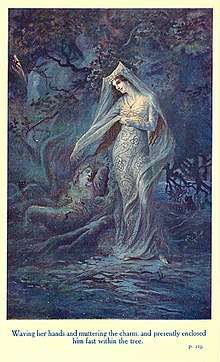
Merlin's apprentice is often Morgan le Fay (in the Prophéties de Merlin along with Sebile and two other witch queens), Arthur's half-sister and sometimes Merlin's lover.[17] Contrary to the many modern works, Merlin and Morgan are never enemies in any medieval tradition. In fact, Merlin loves Morgan so much, that he even lies to Arthur (in the Huth Merlin, which is the only instance of him ever doing such a thing) in order to save her.[18] In the Lancelot-Grail and later accounts, Merlin's eventual undoing came from his lusting after Nimue (or Nymue, Nimue, Niviane, Niniane, Nyneue, Viviane, Vivien among other names and spellings), another female student of his and an unrequited love interest. Merlin's downfall and demise or imprisonment is recounted differently in various versions of the narrative.[note 3] The enchanted prison can be a cave (as in the Lancelot-Grail), a large rock (as in Le Morte d'Arthur), an invisible tower, or a tree; in one version, Nimue confines him in the enchanted forest of Brocéliande with walls of air, visible as mist to others but as a beautiful tower to him.[14] In some texts, including in Le Morte d'Arthur, Nimue then replaces Merlin in the role of Arthur's court mage and adviser as a Lady of the Lake.
In the Prophéties de Merlin, his tomb is unsuccessfully searched for by various parties, including by Morgan and her enchantresses, but cannot be accessed.[20] The legendary Brocéliande is often identified as the real-life Paimpont forest in Brittany. Other purported sites of Merlin's burial include Drumelzier in Tweeddale in Scotland and Carmarthen on Ynys Enlli off the coast of Wales.[21] Both of these locations are also associated with Merlin more generally, including in the 13th-century manuscript known as the Black Book of Carmarthen and in the local lore of Merlin's Oak in the latter case.
Modern fiction
See also
- 2598 Merlin, the asteroid is named in honour of the legendary figure
- Merlin's Cave, a location under Tintagel Castle
Notes
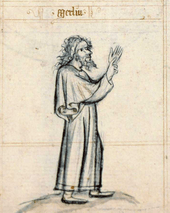
- ↑ He appears as a woodcutter with an axe about his neck, big shoes, a torn coat, bristly hair, and a large beard. He is later found in the forest of Northumberland by a follower of Uther's disguised as an ugly man and tending a great herd of beasts. He then appears first as a handsome man and then as a beautiful boy. Years later, he approaches Arthur disguised as a peasant wearing leather boots, a wool coat, a hood, and a belt of knotted sheepskin. He is described as tall, black and bristly, and as seeming cruel and fierce. Finally, he appears as an old man with a long beard, short and hunchbacked, in an old torn woolen coat, who carries a club and drives a multitude of beasts before him.[14]
- ↑ In the Livre d'Artus, Merlin enters Rome in the form of a huge stag with a white fore-foot. He bursts into the presence of Julius Caesar and tells the emperor that only the wild man of the woods can interpret the dream that has been troubling him. Later, he returns in the form of a black, shaggy man, barefoot, with a torn coat. In another episode, he decides to do something that will be spoken of forever. Going into the forest of Brocéliande, he transforms himself into a herdsman carrying a club and wearing a wolf-skin and leggings. He is large, bent, black, lean, hairy and old, and his ears hang down to his waist. His head is as big as a buffalo's, his hair is down to his waist, he has a hump on his back, his feet and hands are backwards, he is hideous, and is over 18 feet tall. By his arts, he calls a herd of deer to come and graze around him.[14]
- ↑ In the Suite du Merlin, for example, Nimue is a daughter of the king of Northumberland. She is about to depart from Arthur's court, but, with some encouragement from Merlin, Arthur asks her to stay in his castle with the queen. During her stay, Merlin falls in love with her and desires her. Nimue, frightened that Merlin might take advantage of her with his spells, swears that she will never love him unless he swears to teach her all of his magic. Merlin consents, unaware that throughout the course of her lessons, Nimue will use Merlin's own powers against him, forcing him to do her bidding. When Nimue finally goes back to her country, Merlin escorts her. However, along the way, Merlin receives a vision that Arthur is in need of assistance. Nimue and Merlin rush back to Arthur's castle, but have to stop for the night in a stone chamber, once inhabited by two lovers. Merlin relates that when the lovers died, they were placed in a magic tomb within a room in the chamber. That night, while Merlin is asleep, Nimue, still disgusted with Merlin's desire for her, as well as his demonic heritage, casts a spell over him and places him in the magic tomb so that he can never escape, thus causing his death.[19]
References
- ↑ Lloyd-Morgan, Ceridwen. "Narratives and Non-Narrtives: Aspects of Welsh Arthurian Tradition." Arthurian Literature. 21. (2004): 115–136.
- ↑ Katharine Mary Briggs (1976). An Encyclopedia of Fairies, Hobgoblins, Brownies, Boogies, and Other Supernatural Creatures, p.440. New York: Pantheon Books. ISBN 0-394-73467-X
- 1 2 3 Geoffrey of Monmouth (1977). Lewis Thorpe, ed. The History of the Kings of Britain. Penguin Classics. Penguin Books. ISBN 0-14-044170-0.
- 1 2 "Merlin". Oxford English Dictionary. 2008. Archived from the original on June 29, 2011. Retrieved June 7, 2010.
- ↑ Rhys, John: Hibbert Lectures, p. 168.
- 1 2 Koch, p. 321.
- ↑ Xavier Delamarre, Noms de lieux celtiques de l'Europe ancienne, Errance, Paris, 2012 (French)
- ↑ Ashe, Geoffrey. The Discovery of Arthur, Owl Books, 1987.
- ↑ Dames, Michael. Merlin and Wales: A Magician's Landscape, Thames & Hudson Ltd, 2004.
- ↑ Bibliographical Bulletin of the Arthurian Society Vol LIX (2007) p 108, item 302.
- ↑ Tolstoy, Nikolai (1985). The Quest for Merlin. Hamish Hamilton.
- ↑ Curley, Michael, Geoffrey of Monmouth, Cengage Gale, 1994, p. 115.
- ↑ Gough-Cooper, Henry (2012). "Annales Cambriae, from Saint Patrick to AD 682: Texts A, B & C in Parallel Archived 2013-05-15 at the Wayback Machine.". The Heroic Age, Issue 15 (October 2012).
- 1 2 3 Loomis, 1927.
- ↑ Cartlidge, Neil (2012). Heroes and Anti-heroes in Medieval Romance. DS Brewer. ISBN 9781843843047.
- ↑ Chrétien (2014-10-08). Bliocadran: A Prologue to the Perceval of Chrétien de Troyes ; Edition and Critical Study. Walter de Gruyter GmbH & Co KG.
- ↑ "Arthur and Gawain - Robbins Library Digital Projects". rochester.edu. Archived from the original on 19 November 2017. Retrieved 1 May 2018.
- ↑ Goodrich, Peter H. (2004). Merlin: A Casebook. Routledge. pp. 149–150. ISBN 9781135583408.
- ↑ Robert de Boron (1994). James J. Wilhelm, ed. Suite du Merlin. Garland Reference Library.
- ↑ Larrington, Carolyne. "The Enchantress, the Knight and the Cleric: Authorial Surrogates in Arthurian Romance'".
- ↑ "The enchanted wood". www.smh.com.au. The Age. March 26, 2005. Retrieved 2018-07-07.
Sources
- Koch, John T. (2006). Celtic Culture: A Historical Encyclopedia. ABC-CLIO. ISBN 1-85109-440-7.
- Loomis, Roger Sherman (1927). Celtic Myth and Arthurian Romance. Columbia University Press.
External links
| Wikiquote has quotations related to: Merlin |
| Wikimedia Commons has media related to Merlin (legendary figure). |
| Wikisource has original text related to this article: |
- Merlin: Texts, Images, Basic Information, Camelot Project at the University of Rochester. Numerous texts and art concerning Merlin
- Timeless Myths: The Many Faces of Merlin
- BBC audio file of the "Merlin" episode of In Our Time
- Prose Merlin, Introduction and Text (the University of Rochester TEAMS Middle English text series) edited by John Conlea, 1998. A selection of many passages of the prose Middle English translation of the Vulgate Merlin with connecting summary. The sections from "The Birth of Merlin to "Arthur and the Sword in the Stone" cover Robert de Boron's Merlin